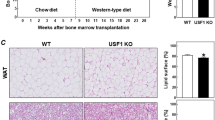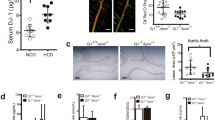Abstract
Liver X receptors (LXRs) are implicated in the regulation of cholesterol homeostasis, inflammatory response and atherogenesis. Administration of LXR agonists inhibits the progress of atherosclerosis, and also increases plasma triglyceride levels, representing an obstacle to their use in treating this disease. The objective of this study was to develop an alternative approach that could overcome this obstacle. Eight-week-old low-density lipoprotein receptor-deficient (LDLR−/−) mice were transplanted with hematopoietic stem cell (HSC)-enriched bone marrow cells transduced with lentivectors expressing either green fluorescent protein (GFP) (Lenti-SP-GFP, control) or LXRα (Lenti-SP-LXRα) driven by a synthetic macrophage promoter. At 4 weeks post-transplant, the mice were fed with a Western diet for 8 weeks and then killed. Compared with Lenti-SP-GFP mice, the Lenti-SP-LXRα mice had a 30% reduction in atherosclerotic lesions, which was accompanied by increases in levels of macrophage expression of cholesterol efflux genes apolipoprotein E and ATP-binding cassette A1, as well as decreases in plasma inflammatory cytokines interleukin-6 and tumor necrosis factor-α. Intriguingly, a 50% reduction of plasma triglyceride level was also observed. We conclude that HSC-based macrophage LXRα gene therapy ameliorates the development of atherosclerosis along with an unexpected concomitant reduction of plasma triglyceride levels in LDLR−/− mice. These findings highlight the potential value of macrophage LXR expression as an avenue for therapeutic intervention against atherosclerosis.
This is a preview of subscription content, access via your institution
Access options
Subscribe to this journal
Receive 12 print issues and online access
$259.00 per year
only $21.58 per issue
Buy this article
- Purchase on Springer Link
- Instant access to full article PDF
Prices may be subject to local taxes which are calculated during checkout





Similar content being viewed by others
References
Zelcer N, Tontonoz P . Liver X receptors as integrators of metabolic and inflammatory signaling. J Clin Invest 2006; 116: 607–614.
Scott J . The liver X receptor and atherosclerosis. N Engl J Med 2007; 357: 2195–2197.
Alberti S, Schuster G, Parini P, Feltkamp D, Diczfalusy U, Rudling M et al. Hepatic cholesterol metabolism and resistance to dietary cholesterol in LXRbeta-deficient mice. J Clin Invest 2001; 107: 565–573.
Janowski BA, Willy PJ, Devi TR, Falck JR, Mangelsdorf DJ . An oxysterol signalling pathway mediated by the nuclear receptor LXR alpha. Nature 1996; 383: 728–731.
Tangirala RK, Bischoff ED, Joseph SB, Wagner BL, Walczak R, Laffitte BA et al. Identification of macrophage liver X receptors as inhibitors of atherosclerosis. Proc Natl Acad Sci USA 2002; 99: 11896–11901.
Joseph SB, McKilligin E, Pei L, Watson MA, Collins AR, Laffitte BA et al. Synthetic LXR ligand inhibits the development of atherosclerosis in mice. Proc Natl Acad Sci USA 2002; 99: 7604–7609.
Levin N, Bischoff ED, Daige CL, Thomas D, Vu CT, Heyman RA et al. Macrophage liver X receptor is required for antiatherogenic activity of LXR agonists. Arterioscler Thromb Vasc Biol 2005; 25: 135–142.
Joseph SB, Laffitte BA, Patel PH, Watson MA, Matsukuma KE, Walczak R et al. Direct and indirect mechanisms for regulation of fatty acid synthase gene expression by liver X receptors. J Biol Chem 2002; 277: 11019–11025.
Schultz JR, Tu H, Luk A, Repa JJ, Medina JC, Li L et al. Role of LXRs in control of lipogenesis. Genes Dev 2000; 14: 2831–2838.
Glass CK, Witztum JL . Atherosclerosis. The road ahead. Cell 2001; 104: 503–516.
Smith JD, Trogan E, Ginsberg M, Grigaux C, Tian J, Miyata M . Decreased atherosclerosis in mice deficient in both macrophage colony-stimulating factor (op) and apolipoprotein E. Proc Natl Acad Sci USA 1995; 92: 8264–8268.
Smith JD . An A+ for macrophages in reducing atherosclerosis? Arterioscler Thromb Vasc Biol 2001; 21: 1710–1711.
He W, Qiang M, Ma W, Valente AJ, Quinones MP, Wang W et al. Development of a synthetic promoter for macrophage gene therapy. Hum Gene Ther 2006; 17: 949–959.
Linton MF, Babaev VR, Gleaves LA, Fazio S . A direct role for the macrophage low density lipoprotein receptor in atherosclerotic lesion formation. J Biol Chem 1999; 274: 19204–19210.
Watanabe Y, Tanaka T, Uchiyama Y, Takeno T, Izumi A, Yamashita H et al. Establishment of a monoclonal antibody for human LXRalpha: detection of LXRalpha protein expression in human macrophages. Nucl Recept 2003; 1: 1.
Laffitte BA, Repa JJ, Joseph SB, Wilpitz DC, Kast HR, Mangelsdorf DJ et al. LXRs control lipid-inducible expression of the apolipoprotein E gene in macrophages and adipocytes. Proc Natl Acad Sci USA 2001; 98: 507–512.
Curtiss LK, Boisvert WA . Apolipoprotein E and atherosclerosis. Curr Opin Lipidol 2000; 11: 243–251.
Beyea MM, Heslop CL, Sawyez CG, Edwards JY, Markle JG, Hegele RA et al. Selective up-regulation of LXR-regulated genes ABCA1, ABCG1, and APOE in macrophages through increased endogenous synthesis of 24(S),25-epoxycholesterol. J Biol Chem 2007; 282: 5207–5216.
Ginsberg H . New perspectives on atherogenesis: role of ABNORMAL triglyceride-rich lipoprotein metabolism. Circulation 2002; 106: 2137–2142.
Joseph SB, Castrillo A, Laffitte BA, Mangelsdorf DJ, Tontonoz P . Reciprocal regulation of inflammation and lipid metabolism by liver X receptors. Nat Med 2003; 9: 213–219.
Branen L, Hovgaard L, Nitulescu M, Bengtsson E, Nilsson J, Jovinge S . Inhibition of tumor necrosis factor-alpha reduces atherosclerosis in apolipoprotein E knockout mice. Arterioscler Thromb Vasc Biol 2004; 24: 2137–2142.
Huber SA, Sakkinen P, Conze D, Hardin N, Tracy R . Interleukin-6 exacerbates early atherosclerosis in mice. Arterioscler Thromb Vasc Biol 1999; 19: 2364–2367.
Popa C, Netea MG, van Riel PL, van der Meer JW, Stalenhoef AF . The role of TNF-alpha in chronic inflammatory conditions, intermediary metabolism, and cardiovascular risk. J Lipid Res 2007; 48: 751–762.
Tontonoz P, Mangelsdorf DJ . Liver x receptor signaling pathways in cardiovascular disease. Mol Endocrinol 2003; 17: 985–993.
Teupser D, Kretzschmar D, Tennert C, Burkhardt R, Wilfert W, Fengler D et al. Effect of macrophage overexpression of murine liver X receptor-{alpha} (LXR-{alpha}) on atherosclerosis in LDL-receptor deficient mice. Arterioscler Thromb Vasc Biol 2008; 28: 2009–2015.
Venkateswaran A, Laffitte BA, Joseph SB, Mak PA, Wilpitz DC, Edwards PA et al. Control of cellular cholesterol efflux by the nuclear oxysterol receptor LXR alpha. Proc Natl Acad Sci USA 2000; 97: 12097–12102.
Rott D, Zhu J, Zhou YF, Burnett MS, Zalles-Ganley A, Epstein SE . IL-6 is produced by splenocytes derived from CMV-infected mice in response to CMV antigens, and induces MCP-1 production by endothelial cells: a new mechanistic paradigm for infection-induced atherogenesis. Atherosclerosis 2003; 170: 223–228.
Ohta H, Wada H, Niwa T, Kirii H, Iwamoto N, Fujii H et al. Disruption of tumor necrosis factor-alpha gene diminishes the development of atherosclerosis in ApoE-deficient mice. Atherosclerosis 2005; 180: 11–17.
Czechowicz A, Kraft D, Weissman IL, Bhattacharya D . Efficient transplantation via antibody-based clearance of hematopoietic stem cell niches. Science 2007; 318: 1296–1299.
Hanna J, Wernig M, Markoulaki S, Sun CW, Meissner A, Cassady JP et al. Treatment of sickle cell anemia mouse model with iPS cells generated from autologous skin. Science 2007; 318: 1920–1923.
Diehl GE, Yue HH, Hsieh K, Kuang AA, Ho M, Morici LA et al. TRAIL-R as a negative regulator of innate immune cell responses. Immunity 2004; 21: 877–889.
Qiao M, Kisgati M, Cholewa JM, Zhu W, Smart EJ, Sulistio MS et al. Increased expression of glutathione reductase in macrophages decreases atherosclerotic lesion formation in low-density lipoprotein receptor-deficient mice. Arterioscler Thromb Vasc Biol 2007; 27: 1375–1382.
Biju KC, Zhou Q, Li G, Imam SZ, Roberts JL, Morgan WW et al. Macrophage-mediated GDNF delivery protects against dopaminergic neurodegeneration: a therapeutic strategy for Parkinson's disease. Mol Ther 2010; 18: 1536–1544.
Sastry L, Johnson T, Hobson MJ, Smucker B, Cornetta K . Titering lentiviral vectors: comparison of DNA, RNA and marker expression methods. Gene Therapy 2002; 9: 1155–1162.
Pawliuk R, Westerman KA, Fabry ME, Payen E, Tighe R, Bouhassira EE et al. Correction of sickle cell disease in transgenic mouse models by gene therapy. Science 2001; 294: 2368–2371.
Acknowledgements
We are grateful to Ronald M Evans (The Salk Institute for Biological Studies, San Diego, CA, USA) for providing mouse LXRα cDNA (pCMX-mLXRα) and Jessica Han for her technical assistance. This study was supported by a research grant from the Research Division of the Department of Veterans Affairs and a Grant-in-Aid from the Texas Affiliate of the American Heart Association.
Author information
Authors and Affiliations
Corresponding author
Ethics declarations
Competing interests
The authors declare no conflict of interest.
Rights and permissions
About this article
Cite this article
Li, G., Biju, K., Xu, X. et al. Macrophage LXRα gene therapy ameliorates atherosclerosis as well as hypertriglyceridemia in LDLR−/− mice. Gene Ther 18, 835–841 (2011). https://doi.org/10.1038/gt.2011.29
Received:
Revised:
Accepted:
Published:
Issue Date:
DOI: https://doi.org/10.1038/gt.2011.29



